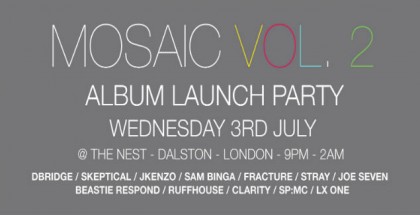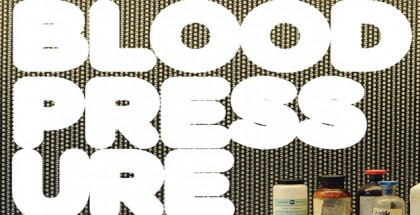FIVE STEPS: Frederic Robinson
In order to make yourself known in an already over-saturated scene it takes not only a unique, identifiable presence of sound, but also an outstanding level of technical prowess. Achieving this can take a solo producer a considerable amount of time, patience and dedication to the craft, yet once in a while one particular artist enters the fray, humble, unannounced and without ceremony, and simultaneously confirms and denies all of these with a single, seemingly effortless flourish of musical brilliance. That track, for us, was Frederic Robinson‘s “Mood Swings”, buried deep within a compilation of excellent tracks in their own right under Gilles Peterson‘s Brownswood imprint.

At once both a celebration of breakbeat culture and a clear, exuberant departure from the norm, that five minutes or so of music single-handedly established the artist a 170 genre all to his own; combining a delicate, emotive precision with an undeniably abyssal creative depth. Every track since that striking debut has recreated that organic, microcosmic aesthetic with enviable consistency, so it comes as no surprise that his latest release on Blu Mar Ten Music is not only one of characteristic excellence, but also a pairing of the two standout talents to emerge from that seminal Electr*c 2 compilation. With great pleasure, we present Frederic Robinson’s Five Steps, who takes us through his first contact with Drum & Bass through to his aforementioned collaborative single with Stray.
Step 1: Origins
I first got in contact with Drum & Bass through Commix‘s Fabriclive 44 when I was 16 years old: I was blown away by the intricate rhythms and delicate sounds on that album. There were no DnB parties where I lived so I only listened to tracks that were suitable for home listening, which contributed to me ignoring most of the dancefloor-orientated music of the genre. My goal back then was to take the rhythms and sound design of the more minimalistic DnB and put it into a more musical context with more development and faster-paced musical ideas.
Step 2: Introducing
I have been making music since I was about 12, which means alongside the necessary acquiring of technical skills I also had to find out which elements in music were important to me and which were not. The first 6 years of my musical output were completely chaotic and have nothing to do with the music I make now. I am still amazed by the crazy things I have on my hard-drive from that time. The first track that I considered good enough to show around was “Mood Swings”. I made it right after buying a decent set of speakers and that made all the difference I suppose. It was also my first release; part of the “electr*c 2” compilation on Gilles Peterson’s Brownswood Recordings. Stray recommended me to them, incidentally. He was, and still is, a big influence because of his elegant handling of DnB stereotypes. I can very much relate to the thought process behind most of his tracks. An important element of music in general is playing with the listener’s expectations and he does it brilliantly.
Step 3: Foundation
My first single was on Diffrent Music (who found my music on Soundcloud) and decided to feature “Laughing at Clouds”, which is my best known track I suppose. The initial thought process behind it was “I should use the sound palette of a standard liquid DnB tune and give it a little twist.” And that’s pretty much how it turned out. I tend to get a bad conscience when I work with overused sounds, but the track is somehow resistant to that. I suppose it is the little gap after each snare… The track I am most proud of is my remix of Pedestrian‘s “Hei Poa“. As you make anything more complex you create an exponential number of new ways it can fail. In my eyes, the remix balances “too much” and “not enough” better than any other track I have ever made. But then, my perspective is very different from my listeners’ so I cannot speak for them.
Step 4: Present
Stray and I had been planning to collaborate for a long time. A long-distance collaboration was never an option (because of its lack of precise communication). I eventually flew over to London, we started “Thumbprint” when I arrived and finished it just before I had to fly back. All that while also getting to know each other as people and as musicians. The creative progress was quite chaotic; a constant stream of ideas that were either fought back or accepted and developed. It was a very new way of working for me (I rarely produce for more than 1 or 2 hours a day): huge fun and very exhausting, since you had to stay focused all the time otherwise the tune would go in a direction you were not happy with. It was a great experience and it will definitely happen again, even if I have to force him 😉
Step 5: Future
Next to lots of studio work I am currently developing a live setup even though all my musical output so far has been completely production oriented. I have no interest in DJing but do not want to miss out on the live aspect of music so for me it is definitely worth the effort. I am not quite sure to what extent this will influence my music, but I expect it to at least slightly shift my focus from technical perfection to expressiveness of fewer musical elements and more “instruments” (meaning sound sources that can actually be played). If you are willing to invest some time into today’s music software, the possibilities are limitless and there is so much more than “quantized button pushing”. So that is what excites me at the moment; it feels like entering a whole new world of music that is completely different from the one I know through production and I cannot wait to present the result of my work.
Stray & Frederic Robinson – ‘When It Rains’ / ‘Thumbprint’ is out now via Blu Mar Ten Music.











